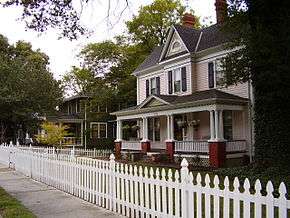Aycock, Greensboro, North Carolina
Aycock is a neighborhood in the northeast section of the United States city of Greensboro, North Carolina. The Aycock neighborhood was named for the Charles B. Aycock Middle School located within the neighborhood. It is filled with late nineteenth and early twentieth century residences and composes one of three historic districts in Greensboro.

Geography
Boundaries
Aycock is bounded as follows:
- on the north by East Bessemer Avenue;
- on the west by the Southern Railway tracks;
- on the east by Lindsay Street; and
- on the south by the Murrow Boulevard.
ZIP code
The 27405 ZIP code corresponds entirely or almost entirely with Aycock.
History
The Aycock neighborhood had its beginnings in 1895, when textile magnate Caesar Cone graded and paved Summit Avenue, a boulevard that connected downtown Greensboro to Cone's manufacturing facilities. The neighborhood's central location to downtown and the Cone mills made it a desirable location for city residents, who erected large homes in Queen Anne styles with turrets, porches laced with brackets and spindles, and elaborate window shapes. Later houses follow Colonial Revival and Craftsman influence, yet nearly all houses in the district share broad front porches, mature trees, and generous floor plans.
The neighborhood was rediscovered in the 1970s by artists and designers who sought spaces with large rooms and modest price tages. Often seen as the funky alternative to "over-the-railroad-tracks" neighbor [Fisher Park], the Aycock area has worked hard to progress the neighborhood while preserving its edge.
Aycock residents are nothing if not ambitious. The neighborhood led citywide efforts to keep major league baseball in their neighborhood in 2003, and developed lofty goals in redevelopment of the Summit Avenue corridor. Defying the perception of historic districts as staid, members of the Aycock neighborhood point to plans for new construction in the form of businesses and residences on vacant land along the Avenue, and their work to reunite their corner of the city with Greensboro's bustling downtown.
Points of interest include the World War Memorial Stadium at 510 Yanceyville Street, constructed as a tribute to veterans of the First World War, and later witness to such legendary ball players as Jackie Robinson, Mickey Mantle, Carl Yastrzemski, Roger Maris, and Derek Jeter. The Greensboro Farmers' Curb Market at 501 Yanceyville Street is open year-round and features fresh flowers, foods, and produce. Notable houses include the castle-like Vaught House at 519 Summit Avenue, the Mediterranean-inspired Sigmund Sternberger House at 712 Summit Avenue, and the Charles B. Aycock School, designed by New York firm Starrett and Van Vleck, located at 811 Cyprus Street.[1]
Parks and public spaces
- Sterburger Park
- World War Memorial Stadium
- Greensboro Curb Market
Notable architects and builders
- Harry Barton
- Starrett and Van Vleck (New York)
- William P. Rose
On the National Register of Historic Places
Summit Avenue National Register Historic District, 1993
References
- Summit Avenue Historic District National Register Nomination, 1993